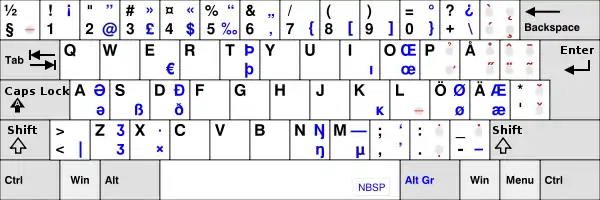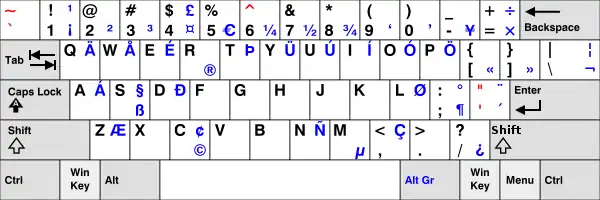AltGr key
AltGr (also Alt Graph) is a modifier key found on many computer keyboards (rather than a second Alt key found on US keyboards). It is primarily used to type characters that are not widely used in the territory where sold, such as foreign currency symbols, typographic marks and accented letters. On a typical, Windows-compatible PC keyboard, the AltGr key, when present, takes the place of the right-hand Alt key: if not engraved as such, that key may still be remapped to behave as though it is,[1] (or emulated using a chord such as Ctrl+Alt). In macOS, the Option key has functions similar to the AltGr key.

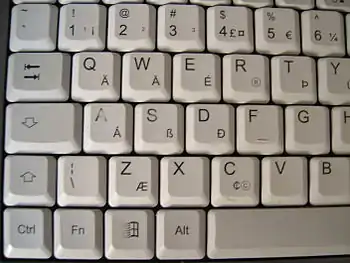
AltGr is used similarly to the Shift key: it is held down while another key is struck in order to obtain a character other than the one that the latter normally produces. AltGr and Shift can also sometimes be combined to obtain yet another character. For example, on the US-International keyboard layout, the C key can be used to insert four different characters:
- C → c (lower case — first level)
- ⇧ Shift+C → C (upper case — second level)
- AltGr+C → © (copyright sign — third level)
- AltGr+⇧ Shift+C → ¢ (cent sign — fourth level)
Meaning

The meaning of the key's abbreviation is not explicitly given in many IBM PC compatible technical reference manuals. However, IBM states that AltGr is an abbreviation for alternate graphic,[2][3] and Sun keyboards label the key as Alt Graph.
AltGr was originally introduced as a means to produce box-drawing characters, also known as pseudographics, in text user interfaces.[4] These characters are, however, much less useful in graphical user interfaces, and rather than alternate graphic the key is today used to produce alternate graphemes.
Function by default national keyboard
Belgium
On Belgian keyboards, AltGr enables the user to type the following characters (the first or only one shown is without ⇧ Shift; when two characters are mentioned, the second one is with ⇧ Shift). Those shown in bold are printed on the keys, and common to all systems; the others may be more variable, or specific to Unix-like systems. For travellers who want to use hotel PCs or cybercafés in Belgium, it is important to know that @ in email addresses is generated by a combination of AltGr + é (unshifted 2).
- Digits row
- AltGr+² → ¬
- AltGr+1 → | and ¡ (inverted exclamation mark, for Spanish)
- AltGr+2 → @ and ⅛
- AltGr+3 → #
- AltGr+4 → ¼
- AltGr+5 → ½ and ⅜
- AltGr+6 → ^ and ⅝ — the ^ is not dead here
- AltGr+7 → { and ⅞ — { is duplicate of AltGr+9, see below
- AltGr+8 → [ and ™ — [ is duplicate of AltGr+^, see below
- AltGr+9 → { and ±
- AltGr+0 → }
- AltGr+) → \ and ¿ — \ is duplicate of AltGr+<, see below
- AltGr+- → dead cedilla and dead ogonek, as in ç and ę
- Top letters row
- AltGr+A → @ and Ω — @ is duplicate of AltGr+2, see above
- AltGr+Z → ł and Ł — both duplicates of AltGr+L, see below
- AltGr+E → € and ¢ — for ¢ see also AltGr+C below
- AltGr+R → ¶ and ®
- AltGr+T → ŧ and Ŧ
- AltGr+Y → ← and ¥
- AltGr+U → ↓ and ↑
- AltGr+I → → and ı (right arrow and Turkish dotless i)
- AltGr+O → œ and Œ
- AltGr+P → þ and Þ (Icelandic thorn)
- AltGr+^ → [ and dead ball, as in å
- AltGr+$ → ] and dead macron, as in ō
- Middle letters row (Home row)
- AltGr+Q → æ and Æ
- AltGr+S → ß (German eszett aka sharp s)
- AltGr+D → ð and Ð (Icelandic edh)
- AltGr+F → đ and ª ("feminine" exponent-a for Spanish etc.)
- AltGr+G → ŋ and Ŋ
- AltGr+H → ħ and Ħ
- AltGr+K → ĸ
- AltGr+L → ł and Ł — see also AltGr+Z, above
- AltGr+M → dead acute and dead double-acute, as in ó and ő
- AltGr+ù → dead acute and dead caron, as in ć and č
- AltGr+µ → dead grave and dead breve, as in ì and ŭ
- Note: Depending on the hardware, the latter key may also be two rows higher, with ← Backspace narrower and ↵ Enter wider to compensate.
- Bottom letters row
- AltGr+< → \
- AltGr+W → «
- AltGr+X → »
- AltGr+C → ¢ and © — for ¢ see also AltGr+⇧ Shift+E above
- AltGr+V → “ and ‘ — "shape 6 above" quotation marks (opening in English, closing in German)
- AltGr+B → ” and ’ — "shape 9 above" quotation marks (closing in English)
- AltGr+, → dead cedilla, as in Ç
- AltGr+; → (nothing) and × (multiplication sign)
- AltGr+: → · and ÷ (middle dot as in Catalan col·lega "colleague", and division sign)
- AltGr+= → dead tilde and dead dot above, as in ñ and İ
Brazil
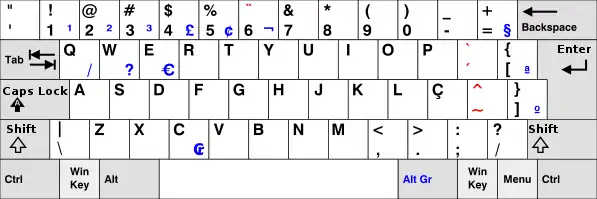

Some notes
- The AltGr+C combination results in the (obsolete) symbol ₢ for the former Brazilian currency, the Brazilian cruzeiro.
- The AltGr+Q, AltGr+W, AltGr+E combinations are useful as a replacement for the "/?" key, which is physically absent on non-Brazilian keyboards.
- Some software (e.g. Microsoft Word) will map AltGr+R to ® and AltGr+T to ™, but this is not standard behavior and was likely an accident owing to the fact that the combinations Ctrl+Alt+R and Ctrl+Alt+T were intended. Windows interprets Ctrl+Alt as AltGr.[5]
France
On AZERTY keyboards, AltGr enables the user to type the following characters:
Germany
On German keyboards, AltGr enables the user to type the following characters, which are indicated on the keyboard:
|
|
|
Windows 8 introduced the ability of pressing AltGr+⇧ Shift+ß to produce ẞ (capital ß). Even though this is usually not indicated on the physical keyboard—potentially due to a lack of space, since the ß-key already has three different levels (ß → "ß", ⇧ Shift+ß → "?", and, as shown above, AltGr+ß → "\")—, it can be seen in the Windows On-Screen Keyboard by selecting the necessary keys with the German keyboard layout selected.
(Some newer types of German keyboards offer the fixed assignment Alt+++H → ẞ.)
Greece
On Greek keyboards, AltGr enables the user to type the following characters:
- Digits row
- AltGr+2 → ²
- AltGr+3 → ³
- AltGr+4 → £
- AltGr+5 → §
- AltGr+6 → ¶
- AltGr+8 → ¤
- AltGr+9 → ¦
- AltGr+0 → °
- AltGr+- → ±
- AltGr+= → ½
- Top letters row
- AltGr+Ε → €
- AltGr+Ρ → ®
- AltGr+Υ → ¥
- AltGr+[ → «
- AltGr+] → »
- AltGr+\ → ¬
- Middle letters row
- AltGr+; → ΅(a dead key:AltGr+; then i → ΐ)
- Bottom letters row
- AltGr+Ψ → ©
Some of these key combinations also result in different characters if the polytonic layout is used.
Hebrew
On Hebrew keyboards, AltGr enables the user to type the following characters:
|
There are several combinations using AltGr that activate Hebrew vowels.
Yiddish
Using a Hebrew keyboard, one may write in Yiddish as the two languages share many letters. However, Yiddish has some additional digraphs and a symbol not otherwise found in Hebrew which are entered via AltGr.
|
Italy
On Italian keyboards, AltGr enables the user to type the following characters:
|
|
There is an alternate layout, which differ just in disposition of characters accessible through AltGr and includes the tilde and the curly brackets.
Latvia
The following letters can be input in the Latvian keyboard layout using AltGr:
Lowercase letters
|
Uppercase letters
|
North Macedonia
On Macedonian keyboards, AltGr enables the user to type the following characters:
|
|
|
The Netherlands
- Digits row
- AltGr+1 → ¹ and ¡
- AltGr+2 → ²
- AltGr+3 → ³
- AltGr+4 → £ and ¤
- AltGr+5 → €
- AltGr+6 → ¼
- AltGr+7 → ½
- AltGr+8 → ¾
- AltGr+9 → ‘
- AltGr+0 → ’
- AltGr+- → ¥
- AltGr+= → × and ÷
- Top letters row
- AltGr+Q → ä and Ä
- AltGr+W → å and Å
- AltGr+E → é and É
- AltGr+R → ®
- AltGr+T → þ and Þ (Icelandic and Old English thorn)
- AltGr+Y → ü and Ü
- AltGr+U → ú and Ú
- AltGr+I → í and Í
- AltGr+O → ó and Ó
- AltGr+P → ö and Ö
- AltGr+[ → «
- AltGr+] → »
- AltGr+\ → ¬ and ¦
- Middle letters row (Home row)
- AltGr+A → á and Á
- AltGr+S → ß (German eszett aka sharp s) and §
- AltGr+D → ð and Ð (Icelandic edh)
- AltGr+L → ø and Ø
- AltGr+; → ¶ and °
- AltGr+' → ´ and ¨
- Bottom letters row
- AltGr+Z → æ and Æ
- AltGr+C → © and ¢
- AltGr+N → ñ and Ñ
- AltGr+M → µ
- AltGr+, → ç and Ç
- AltGr+/ → ¿
Nordic countries and Estonia
The keyboard layouts in the Nordic countries (Denmark (DK), Faroe Islands (FO), Finland (FI), Norway (NO) and Sweden (SE) as well as in Estonia (EE)) are largely similar to each other. Generally the AltGr key can be used to create the following characters:
|
|
Other AltGr combinations are peculiar to just some of the countries:
Finnish multilingual
The Finnish multilingual keyboard standard adds many new characters to the traditional layout via the AltGr key, as shown in the image below (the blue characters can be written with the AltGr key; several dead key diacritics, shown in red, are also available as an AltGr combination).[6][7]
Poland
Typewriters in Poland used a QWERTZ layout specifically designed for the Polish language with accented characters obtainable directly. When personal computers became available worldwide in the 1980s, commercial importing into Poland was not supported by its communist government, so most machines in Poland were brought in by private individuals. Most had US keyboards, and various methods were devised to make special Polish characters available. An established method was to use AltGr in combination with the relevant Latin base letter to obtain a precomposed character with a diacritic; note the exceptional combination using x instead of the base letter z, as the Latin base letter has been reserved for another combination:
- AltGr+A → ą
- AltGr+C → ć
- AltGr+E → ę
- AltGr+L → ł
- AltGr+N → ń
- AltGr+O → ó
- AltGr+S → ś
- AltGr+U → €
- AltGr+X → ź
- AltGr+Z → ż
At the time of the political transformation and opening of commercial import channels this practice was so widespread that it was adopted as the de facto standard. Nowadays most PCs in Poland have standard US keyboards and use the AltGr method to enter Polish diacritics. This layout is referred to as Polish programmers' layout (klawiatura polska programisty) or simply Polish layout.
Another layout is still used on typewriters, mostly by professional typists. Computer keyboards with this layout are available, though difficult to find, and supported by a number of operating systems; they are known as Polish typists' layout (klawiatura polska maszynistki). Older Polish versions of Microsoft Windows used this layout, describing it as Polish layout. On current versions it is referred to as Polish (214).
Romania
The keymap with the AltGr key:
â ß € r ț y u î o § „ ”
ă ș đ f g h j k ł ;
z x © v b n m « »
South Slavic Latin
On South Slavic Latin keyboards (used in Croatia, Slovenia, Bosnia and Herzegovina, Montenegro and Serbia), the following letters and special characters are created using AltGr:
|
|
|
Turkey
In Turkish keyboard variants the AltGr can be used to display the following characters:
- AltGr+a → æ
- AltGr+s → ß
- AltGr+e → €
- AltGr+t → ₺
- AltGr+q → @
- AltGr+ı → i
- AltGr+ü a → ã
- AltGr+ğ a → ä
- AltGr+ş a → á
- AltGr+, a → à
United Kingdom and Ireland
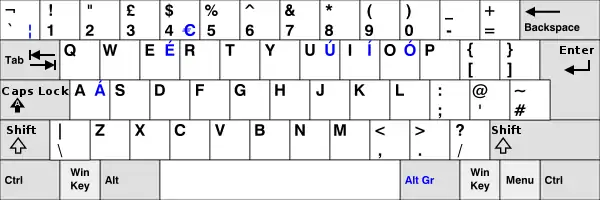
|
|
In UK and Ireland keyboard layouts, only two alternative use symbols are printed on most keyboards, which require the AltGr key to function. These are:
- € the euro sign. Located on the "4/$" key.
- ¦ the broken bar symbol. Located on the "`/¬" key, to the immediate left of "1".
Using the AltGr key on Linux produces many foreign characters and international symbols, e.g. ¹²³€½{[]}@łe¶ŧ←↓→øþæßðđŋħjĸł«»¢“”nµΩŁE®Ŧ¥↑ıØÞƧЪŊĦJ&Ł<>©‘’Nº×÷· (If reconfigured as a compose key, an even larger repertoire is available).
With the UK extended keyboard setting (below), Chrome OS offers a large repertoire of symbols and precomposed characters.
Scotland and Wales
For the diacritics used by Welsh (ŵ and ŷ) and Scots Gaelic (à, è, ì, ò and ù), the UK extended keyboard setting is needed. This makes available AltGr+6 (for circumflex accent) and AltGr+` (for grave accent) as dead keys.
UK extended keyboard layout
The UK-Extended keyboard mapping (available with Microsoft Windows, Linux and ChromeOS) allows many characters with diacritical marks (including those used in other European countries) to be generated by using the AltGr key or dead keys in combination with others.
| ¬ ◌ ◌ ¦ | ! ¡ 1 ¹ | " ½ 2 ◌ | £ ⅓ 3 ³ | $ ¼ 4 € | % ⅜ 5 ½ | ^ ⅝ 6 ◌ | & ⅞ 7 { | * ™ 8 [ | ( ± 9 ] | ) ° 0 } | _ ¿ - \ | + ◌ = ◌ |
| tab | Q Ω q @ | W Ẃ w ẃ | E É e é | R ® r ¶ | T Ŧ t ŧ | Y Ý y ý | U Ú u ú | I Í i í | O Ó o ó | P Þ p þ | { ◌ [ ◌ | } ◌ ] ◌ |
| 🔍 | A Á a á | S § s ß | D Ð d ð | F ª f đ | G Ŋ g ŋ | H Ħ h ħ | J ◌ j ◌ | K & k ĸ | L Ł l ł | : ◌ ; ◌ | @ ◌ ' ◌ | ~ ◌ # ◌ |
| shift | | ¦ \ | | Z < z « | X > x » | C Ç c ç | V ‘ v “ | B ’ b ” | N N n n | M º m µ | < × , ─ | > ÷ . · | ? ◌ / ◌ |
Notes: Dotted circle (◌) is used here to indicate a dead key. The ` (grave accent) key is the only one that acts as a free-standing dead key and thus does not respond as shown on the key-cap. All others are invoked by AltGr.
AltGr+⇧ Shift+0 (°) is a degree sign; AltGr+⇧ Shift+M (º) is a masculine ordinal indicator. For a complete list of the characters available using dead keys, see QWERTY#Chrome OS.
United States
Most keyboards sold in the US do not have an (engraved) AltGr key. With some Operating Systems, its function may be emulated using Ctrl+Alt or, given the right keyboard mapping, one of the Alt keys can be made to have the AltGr functionality (usually the right Alt key).
Control + Alt as a substitute
Originally, US PC keyboards (specifically, the US 101-key PC/AT keyboards) did not have an AltGr key because it was relevant only in non-US markets: US keyboards simply had "left" and "right" Alt keys.
On most non-US keyboards, the right-hand Alt key is engraved as Alt Gr (or its national language equivalent). In reality, because the same scancode is generated irrespective of the superficial engraving, the actual function of the key is determined by the Operating System (or, exceptionally, by application software). Consequently, some keyboard mappings treat the right-Alt key as an AltGr, even though it is not engraved as such. Conversely, on some compact keyboards like those of netbooks, the right Alt key may be missing altogether. To allow the specific functionality of AltGr when typing non-English text on such keyboards, some OSs such as Microsoft Windows emulate the function by treating the Alt key and Control key pressed together as an AltGr key:
- Ctrl+Alt ≈ AltGr.
Therefore, Microsoft recommends that this combination not be used as a keyboard shortcut in Windows applications as, depending on the keyboard layout and configuration, someone trying to type a special character with it may accidentally trigger the application shortcut.[5]
US-International
In the US-International keyboard layout and Microsoft Windows with the matching keyboard setting, the AltGr key can be used to enter the following characters:
¡ ² ³ ¤ € ¼ ½ ¾ ‘ ’ ¥ ×
ä å é ® þ ü ú í ó ö « »
á ß ð ø ¶ ´ ¬
æ © ñ µ ç ¿
and, in combination with the Shift key:
¹ £ ÷ Ä Å É Þ Ü Ú Í Ó Ö Á § Ð Ø ° ¨ ¦ Æ ¢ Ñ Ç
Note that many of these symbols can also be entered using dead keys; for example ä can be entered with " followed by a.
For comparison, the US-International keyboard layout follows. Note that the "`/~" key (left of number 1) has been omitted; the AltGr key does not influence the characters typed with this key.
1 2 3 4 5 6 7 8 9 0 - = q w e r t y u i o p [ ] a s d f g h j k l ; ' \ z x c v b n m, . /
Other operating systems such as Linux and Chrome OS increase the repertoire of glyphs provided. In some variations of Linux, the AltGr key can be reconfigured to become a compose key, giving access to a much larger repertoire.
X Window System
In the X Window System (GNU/Linux, BSD, Unix), AltGr can often be used to produce additional characters with almost every key on the keyboard. Furthermore, with some keys, AltGr will produce a dead key; for example on a UK keyboard, semicolon can be used to add an acute accent to a base letter, and left square bracket can be used to add a trema:
- AltGr+; followed by E → é
- AltGr+[ followed by ⇧ Shift+O → Ö
This use of dead keys enables one to type a wide variety of precomposed characters that combine various diacritics with either uppercase or lowercase letters, achieving a similar effect to the Compose key.
Keyboard maps
Below are some diagrams and examples of country-specific key maps. For the diagrams, the grey symbols are the standard characters, yellow is with ⇧ Shift, red is with AltGr, and blue is with ⇧ Shift+AltGr.
Danish keyboard
The Danish keymap features the following key combinations:
- AltGr+⇧ Shift+Q → Ω
- AltGr+O → ø
- AltGr+M → µ
Italian keyboard
The Italian keymap includes, among other combinations, the following:
|
|
Norwegian keyboard

Swedish keyboard

See also
References
- Microsoft Support. "How to use the United States-International keyboard layout in Windows 7, in Windows Vista, and in Windows XP". Microsoft. Retrieved 30 May 2020.
- "Keyboard Technical Reference". ibm.com. Archived from the original on 14 January 2006. Retrieved 4 June 2005.
- "IBM Globalization – Alternate graphic". ibm.com.
- Kaplan, Michael S.: "To start press the ALTGR key." Hmm... where's the ALTGR key?. 28 December 2004.
- Raymond Chen (29 March 2004). "Why Ctrl+Alt shouldn't be used as a shortcut modifier". Microsoft.
- SFS 5966 Keyboard layout. Finnish-Swedish multilingual keyboard setting. Finnish Standards Association SFS. 3 November 2008.
- Kotoistus: Uusi näppäinasettelu = Status of the new Keyboard Layout Archived 27 July 2011 at the Wayback Machine. A bi-lingual (Finnish + English) presentation page collecting drafts of the Finnish Multilingual Keyboard. CSC – IT Center for Science Ltd. Page updated 28 December 2006.
| Esc | F1 | F2 | F3 | F4 | F5 | F6 | F7 | F8 | F9 | F10 | F11 | F12 | PrtScn/ SysRq |
Scroll Lock |
Pause/ Break |
|||||||||
 |
Insert | Home | PgUp | Num Lock |
∕ | ∗ | − | |||||||||||||||||
| Delete | End | PgDn | 7 | 8 | 9 | + | ||||||||||||||||||
| 4 | 5 | 6 | ||||||||||||||||||||||
| ↑ | 1 | 2 | 3 | Enter | ||||||||||||||||||||
| ← | ↓ | → | 0 Ins |
. Del | ||||||||||||||||||||
